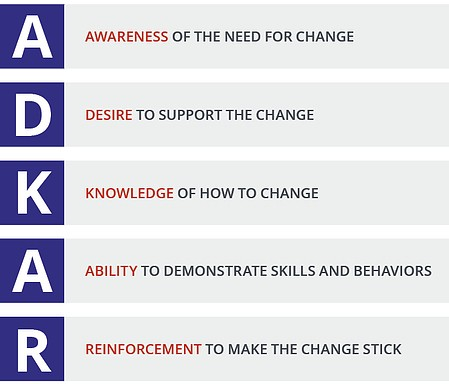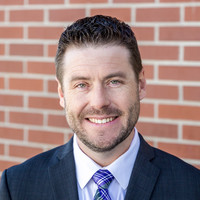変革とはプロセスであるChange Is a Process
by Tim Creasey
変革はイベントではなく、プロセスとして生じます。組織の変革は、急に発生するようなものではありません。通常は、まず発表やキックオフミーティングがあり、そこで稼働開始となる日が知らされ、徐々に開始されていくものです。個人の変革は、メールで通知を受け取ったり、研修プログラムを受講したりすることだけで、簡単に達成するものではありません。 変革において、私たちは自身の現在の知識レベルや現在の状態を起点にし、変革後の「目指す姿」に向かう移行期間を経て、ゴールである新しい行動様式や新たな仕事のやり方を得られるようになります。 変革をプロセスとして取り扱うことについては、「チェンジマネジメントの7つの概念」で語られています。また、変革の成功、およびチェンジマネジメントの成功における主要な要素の1つとなっています。変革をプロセスとして取り扱い、また、個別のフェーズに分けることで、 個人の変革におけるアプローチをより適切にカスタマイズし、調整することができ、さらには、各個人 が自分の行動や仕事のやり方を変化させ、確実に変革を成功に導くことができるようになります。
プロセスとしての変革を理解する
自然界において変革や変化がプロセスとして起こるのを見かけることは多くあることでしょう。例えば、さなぎが蝶に変身したり、冬から春に季節が移り変わったりすることを思い出せば、変化がプロセスであることを容易に理解することができます。しかし、プロジェクトや取組みによって組織を変革しようとする場合には、多くの人は、変革は即座には起こらないものであるという事実を忘れてしまいがちです。

変革はプロセスであるということを理解するための最も容易かつ最も基本的なアプローチは、変革を理解しやすい個別の要素に分解することです。ここでは、重要なフレームワークとして、変革の3つのフェーズをご紹介いたします。Prosci®では、変革を「現在」「移行期」「将来」の3つのフェーズに分けて定義しています。

現在‐現在の状態とは、まさに「今」の状態をさします。現在の状態を構成する要素としては、プロセス、行動様式、ツール、テクノロジー、組織構造、および職務上の役割などがあげられます。今まさに私たちがおかれている状況そのものが「現在」の状態だと言えます。「現在」の状態の中には、改善したほうがよさそうだと思えることや、ベストな状態とは言い難いこともあるかもしれませんが、多くの人にとっては「現在」の状態は馴染み深いものであり、居心地がよいものなのです。また、現在の状態は、今の自分が成功を収めてきた場所であり、かつ自身が評価される場所でもあります。そして何より、現在の状態は「知っている」状態であると言えます。
移行期‐移行期の状態は、混乱した無秩序な状態です。物事は予測できず、常に流動的です。移行期の状態においては、混乱ゆえに感情的になることもあります。その感情は失望、不安、怒り、恐怖、安堵等、人によってさまざまです。移行期の状態では、生産性が低下することが予想されます。なぜなら、移行期の状態においては、私たちは日常的な努力を継続しつつ、新しい視点を受け入れ、新しい行動様式や仕事のやり方を学ぶことを要求されるためです。移行期は「挑戦」の状態とも言えます。
将来‐将来の状態は、私たちが変革後にめざす状態をさします。いわば、ゴールです。これは、完全に定義されていないことが多く、 私たちが移行期の状態を切り抜けている間に変化することがあります。多くの場合、将来の状態では、現在の状態と比較し、状態が改善され、パフォーマンスが向上することが求められます。将来の状態は多くの人にとって不安なものであるともいえます。将来の状態は、もしかすると、個人の目標やキャリアパスと一致していないかもしれませんし、将来の成功は保証されたものではありません。そして、現在の状態との決定的な違いは、将来の状態は「未知」の状態ということです。
変革の3つのフェーズを正しく理解し概念を活用することにより、変革が実際にどのように起こるかについて具体化することができます。その変革が新たなシステムの導入であろうと、新たなプロセスであろうと、新しい機械や仕組みであろうと、または新しいチームや体制であろうと、そこには必ず、現在、移行期、将来、の3つのフェーズが存在します。
さて、あなたの場合はどうでしょうか。あなたが取り組んでいるプロジェクト、または影響を及ぼしているプロジェクトについて考えてみてください。以下の表を使って変革の3つのフェーズをそれぞれ定義し、その 状態を表現する3つのタイプ の形容詞を考えてみてください。


また、プロセスとしての変革について、理解をもう1歩進めて、現在の状態、移行期の状態、および将来の状態に対し、組織内の誰が重点的に時間を費やしているかについて考えてみましょう。以下の表は、3種類の立場の異なる人物が、変革の各状態をどのように見ているかを示しています。
エグゼクティブおよびシニアリーダーにとっては、将来の状態における活動が主要な場となります。彼らは将来において、(6か月後、1年後、3年後・・・)組織がどのように機能すべきかを決定することに責任を負い、またその成果を報酬として受け取ります。プロジェクトチームにとっては、移行期における活動が主要な場となります。プロジェクトチームは、組織を変革するためのプランを調査し、道筋を決定し、ソリューションを策定します。社員、マネージャーおよび上位監督者にとっては、現在の状態における活動が主要な場となります。彼らは、変革を実施するために自分の業務を単純に停止することはできません。変革が実施されている間も、現在の役割を全うし、組織を機能させ続けることに責任を負います。
ここで変革に関するコミュニケーションに断絶が起きると、重大な悪影響が生じる可能性があります。エグゼクティブやシニアリーダーは、ビジョンについて語りがちですが、場合によってはこれが弊害をもたらすこともあります。プロジェクトチームは、自分たちのソリューションの詳細や、変革におけるマイルストーンやスケジュールに、コミュニケーションを集中させる傾向にあります。社員は、自分たちが今行っていること(現在の状態)を変革する必要がある理由をまず知りたがる傾向があります。チェンジマネジメント実務プロフェッショナルは、変革の3つのフェーズの間にあるギャップを埋める重要な役割を果たします。
プロセスとしての変革の管理
変革が単発のイベントとしてではなく、プロセスであるということを考え始めると、「変革のプロセスをどのように管理するのか」という疑問が残ります。その答えとして、プロセスとしての変革の管理は、以下の2つのレベルで行われます。
個人レベルの変革
変革によって影響を受けるそれぞれの従業員やマネージャーは、自身の個人レベルの変革プロセスを辿らなければなりません。例えば、5人に影響を及ぼす変革の場合、変革の影響を受ける5人それぞれが、自分の現在の状態から出発し、自分の移行期の状態を経て、自分自身の将来の状態に到達しなければなりません。プロジェクトが500人に影響を及ぼす場合、500人分の現在‐移行期‐将来のプロセスを辿る必要があります。さらに何か大きな変化によって5,000人に影響を及ぼす場合、5,000人が現在の状態から出発して将来の状態に到達しなければなりません。これがチェンジマネジメントの本質です。すなわちチェンジマネジメントは、組織のパフォーマンスを向上させるための変革やプロジェクトにおいて不可欠なものとして、個人の変革をサポートし、スムーズな移行を行うための支援を行います。
Prosci のADKAR® モデルは、個人が自身の現在の状態から将来の状態への移行が成功するための要素をより詳細に説明しています。ADKAR® モデルは、変革の成功に係る5つの構成要素「Awareness(認知)」、「Desire(欲求)」、「Knowledge(知識)」、「Ability(能力) 」および「Reinforcement®(定着)」によって成り立っています。

変革の舞台が家庭であろうと、コミュニティであろうと、または職場であろうと、変革の影響を受ける個人が「Awareness(認知)」、「Desire(欲求)」、「Knowledge(知識)」、「Ability(能力) 」および「Reinforcement®(定着)」を習得している場合、変革は成功します。個人の変革プロセスに係るこの結果志向のモデルは、チェンジマネジメント実務プロフェッショナルにとって新たな視座となることでしょう。個人の変革プロセスについて理解した有能なプロフェッショナルであれば、例えば、自分の仕事を単なる「コミュニケーションプランの作成」とみなすのではなく、「認知の創出」であると捉えることができるはずです。
最後に、個人レベルにおけるプロセスとしての変革に関する、2つの考察結果についてお話します。第1に、人々が変革プロセスを開始する時点はさまざまです。例えば、パイロットプログラムにかかわるチームは、その他の大勢の従業員たちの何か月も前に変革について知り、変革プロセスを開始する可能性があります。第2に、各個人がプロセスを辿るのにかかる時間の長さは各自さまざまです。例えば、変革の必要性を認知することには数時間しかかからない人もいる一方で、「変革が必要な理由を理解した」と言える段階に到達するまでに数日または数週間かかる人もいます。プロジェクトまたは変革の影響を受ける個人の変革プロセスに目を向け、管理し始めることによって、各個人の成功を実現させるとともに、組織全体の変革の成功に導くことができます。
組織レベルの変革
組織レベルの変革を管理するにあたり、変革をプロセスとみなすことは、チェンジマネジメントの取組みの優先順位および内容を決定するのに役立ちます。
第1に、組織のチェンジマネジメント自体のプロセスは、プロジェクトや取組みの実行に伴う変革のプロセスと並行して行うべきです。組織のチェンジマネジメントに係るProsci3フェーズプロセスは、第1フェーズ‐変革の準備(現在の状態において行われる)、第2フェーズ‐変革のマネジメント(移行期の状態において行われる)、および第3フェーズ‐変革の定着化(将来の状態において行われる)について、具体的な活動を示しています。
第2に、リサーチの結果では、チェンジマネジメント実務プロフェッショナルは個人の変革プロセスの推進を支援するための5つのツールまたはレバー(すなわち、コミュニケーションプラン、スポンサーロードマップ、コーチングプラン、トレーニングプラン、およびレジスタンスマネジメントプラン)を持っています。現在の状態にあるか、移行期の状態にあるか、または将来の状態にあるかに応じて、効果的なツールは異なり、またその内容も変化します。以下に2つの例を挙げて説明します。
トレーニングプラン ‐トレーニングプランは、チェンジマネジメントの取組みにおける主要な要素の1つです。従業員は一般的に、自身の日常業務に変革を導入するにあたり、新しいスキルや能力を必要とします。トレーニングプランは、従業員が変革プロセスのどの段階にいるかに基づいて効果的に優先順位付けされていなければなりません。従業員が変革について知った直後(すなわち、従業員が間違いなく現在の状態にある時点)に行われるトレーニングプランは、効果的ではありません(しかしこれは、変革を進めるうえで最初のアクションが「従業員にトレーニングを受講させること」であると多くの事例で見られる残念な現実です)。トレーニングは、従業員が現在の状態から出発し、移行期に入り始めてから実施されるべきです。
コミュニケーションプラン ‐効果的なコミュニケーションプランの内容は、従業員が変革プロセスのどの段階にいるかに並行する、もしくは一致するものです。コミュニケーションの初期段階においては、まず現在の状態が機能しておらず、変革されなければならない理由を説明することに焦点を合わせるべきです。その後の変革の段階におけるコミュニケーションにおいて初めて、プロジェクトまたは変革の取組みで目指す最終的なゴールやビジョン、詳細事項に焦点を合わせることができます。従業員に対する最初のコミュニケーションで変革の詳細事項、マイルストーンおよびビジョンに焦点を合わせた場合、従業員は未回答の質問「なぜ?」を抱えたままになり、これによって細かな実施プロセスを処理する能力を低下させてしまいます。組織の視点に立って、プロセスとしての変革を管理することにより、正しい活動が正しい時期に行われること、また、従業員が自身の個人の変革プロセスを辿るために必要な正しい情報を得ることが変革の成功の確実性を向上させます。
チェンジマネジメントにおける重要なポイント
1. 変革を、単発のイベントや出来事としてではなく、プロセスとして取り扱いましょう。2. 各個人がプロセスとしての変革を体験します。個人が変革プロセスのどの段階にいるかを理解し、段階に応じたチェンジマネジメント活動を実施・評価しましょう。3. 誰しもが同じように変革プロセスを辿ることはありません。変革プロセスを辿るスピードは人それぞれです。4. 組織のチェンジマネジメントにかかわる取組みや活動は、変革プロセスの段階と関連付けられている必要があります。
【無料】チェンジマネジメントの基礎知識

組織の変革プロジェクトが技術要件とマイルストーンを満たしていたとしても、目標と成果を実現できない可能性があります。これは何故でしょうか? 答えはチェンジマネジメントです。チェンジマネジメントを採用している組織は、予定どおりまたは予定より早く、予算内で、プロジェクトの目標を達成する可能性が高くなります。これは、データからも明確に示されています。

著者:ティム・クリーシー(Tim Creasey)プロサイ(Prosci)のチーフイノベーションオフィサー(CIO)。チェンジマネジメントのオピニオンリーダーとして、世界的な評価を受けている。変革の人的側面を管理し、組織としての結果を生み出すことに関して、世界最大規模の知識体系基盤を形成している。












